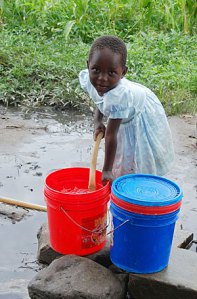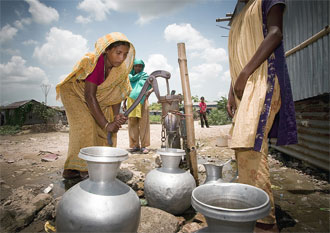The visionary architect Buckminster Fuller believed that a single design could save the world. That ethos is being carried forward by the Buckminster Fuller Institute, which every year holds a contest to create a design with maximum social impact; the winner gets a seed grant of $100,000. Below is information on one of the competition finalists.
Finalist – Umande Trust, GOAL Ireland Partnership
60% of Nairobi’s population lives in slums which are characterized by inadequate housing and sanitation conditions. Human waste lies on paths and drains and an average of 650 people share each toilet cubicle. The most prevalent childhood sicknesses and 40% of infant mortality are caused by inadequate sanitation. To address this, Umande Trust, a Kenyan rights-based organization, has developed the BioCentre concept. This is a biogas generating latrine block, managed by community groups, which can be located anywhere in a slum as it treats human waste in-situ without requiring sewerage infrastructure.
It comprises of the following:
• Digester: Mixes water and human waste in anaerobic conditions to make biogas; remaining liquid effluent is 90% pathogen free and filtered on site.
• BioGas: Used for cooking and can be linked to children’s feeding projects. It reduces carbon emissions by converting methane to CO2 and water and by substituting the need for other fuels.
• Toilets and washrooms: Ground floor to ensure disabled access with free ‘child only’ cubicles
• Water Kiosk: selling affordable clean water
• Upper Floors: Maximizes restricted urban space, has a hall and ancillary rooms for community and livelihoods activities eg cottage industries or restaurant.
Income generated through rental can subsidize the operation of the toilets. The BioCentre can be built with locally available technology, local unskilled labor and requires minimal maintenance as it has no movable parts. GOAL, an international NGO working with Umande, adds value to the BioCentre concept by linking it to a comprehensive community mapping analysis which highlights specific locations in greatest need of improved sanitation and by incorporating in each BioCentre a room for a community health worker. These are community members, trained by GOAL to disseminate hygiene and health information, e.g. to women queing for water each day, and to make referrals to local institutions for health, HIV/AIDS and child protection issues. Most other initiatives offering sanitation services are plot-based pit latrines which are exhaust human waste into nearby rivers, regularly overflow and often charge high usage fees. The BioCentre is a breakthrough, as it treats human waste in-situ, offers affordable sanitation through its mechanism of subsidizing operational costs, reduces carbon emissions and links to hygiene promotion, health and child protection services.
Describe the current stage of your initiative and your implementation plan over the next three years
Umande Trust has so far completed 12 BioCentres in Kenya. They are scattered amongst various communities and have a verifiable local impact. The Umande Trust, GOAL Ireland partnership aims to achieve a community level impact by focusing on the whole of one Nairobi settlement, Mukuru (population 185,000).
Currently the initiative is completing a participatory urban appraisal on water, sanitation, waste management and drainage. This has highlighted inadequate sanitation as the most pressing need and recommends addressing this by:
• increasing the number of affordable, sustainable, community-managed latrine blocks
• increasing the number of plot-based latrines and improving the quality of existing ones
• developing a community sanitation fund as a self-propagating mechanism for scaling up the intervention
Over the next 3 years, the project aims to reach a critical mass of 20 BioCentres which will serve 12,000 daily users. Each BioCentre will donate 10% of its profits to a community sanitation fund, and this will generate over 10,000 USD per year. This fund will be used to scale up the project through providing leverage to attract Government Decentralized Funding (government allocations to local development initiatives) to develop 2 further BioCentres each year which will then also contribute 10% of profits to the fund. The fund may alternatively support the construction and upgrading of 50 ventilation-improved plot-based latrines each year through partnership with small-scale service providers. These will have lined pits to enable them to be emptied by mobile latrine exhausters into sump tanks which will link to the city sewerage network.
 Stanford Report, April 22, 2009 – Seeking low-cost solutions to sanitation crisis in Africa
Stanford Report, April 22, 2009 – Seeking low-cost solutions to sanitation crisis in Africa




